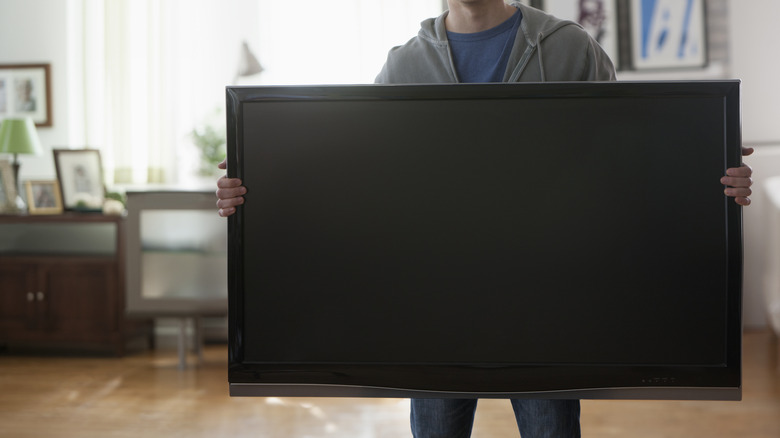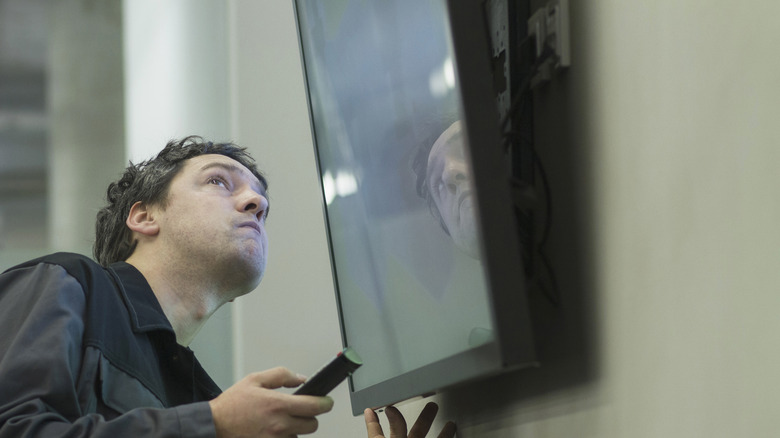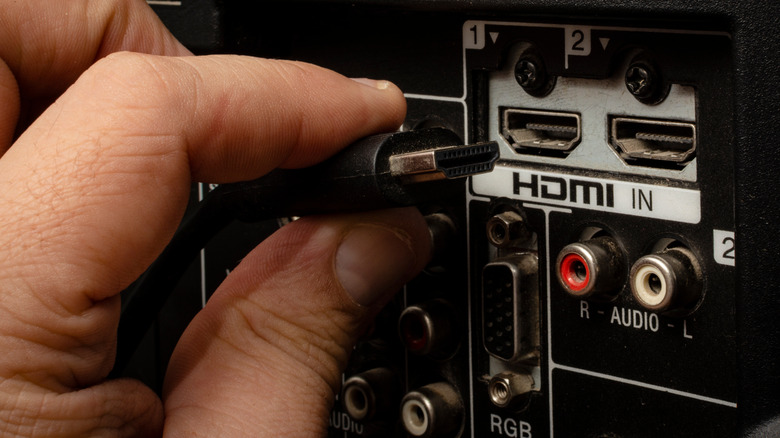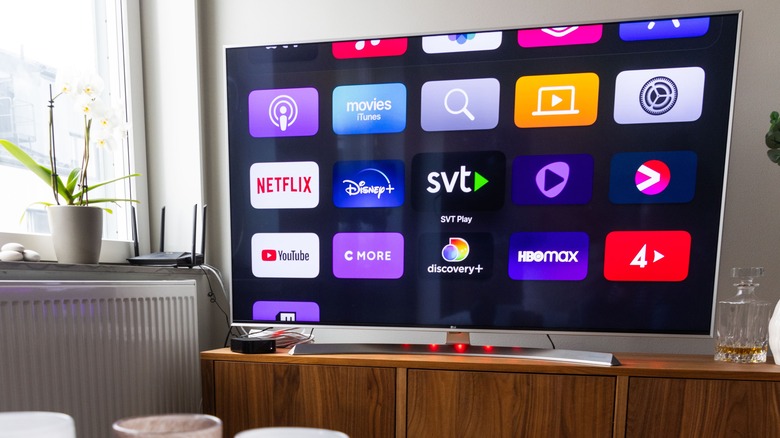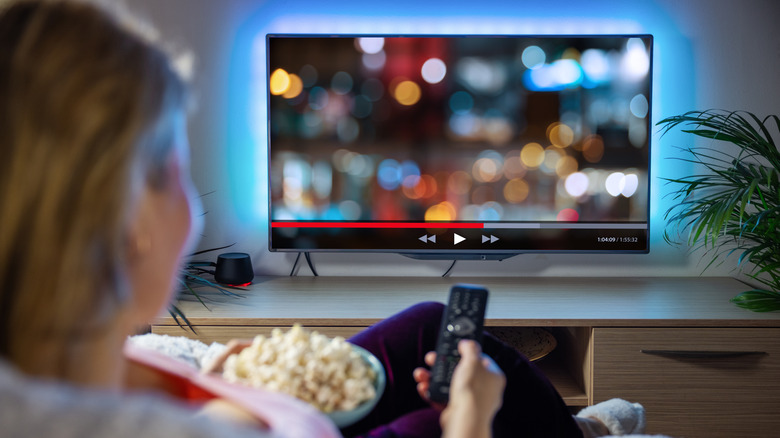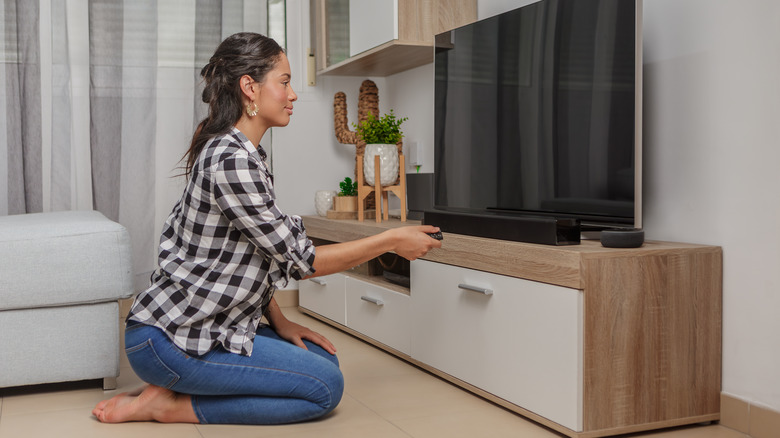5 Things To Look For When Buying A Used TV
Buying a used TV can make a lot of sense for a lot of reasons. After all, TVs can be expensive, and buying one used can help you get more features and a bigger screen for your money. Still, we all want to avoid getting burned when buying used electronics, so we'd understandably approach buying a used TV with caution. While buying a new TV is a pretty straightforward process, buying one used can be filled with uncertainty as you try to confirm the asking price is fair and that it meets your expectations. That means doing some extra homework that goes above and beyond comparing specs, price, and the reputation of the TV brand you're thinking about buying.
Before you start shopping, you should keep in mind that you'll probably have a hard time finding the latest TV models on the used market. When you buy a TV secondhand, depending on where you purchase it, you'll also get a lesser warranty or miss out on warranty protections altogether. However, buying a TV through the eBay Refurbished program or a similar certified resale program can provide you with some peace of mind when purchasing a secondhand TV because it comes with a one- or two-year warranty when certain conditions are met.
On the other hand, buy a TV directly from a private owner, and you'll likely have no warranty or return options if something goes wrong, making it a much more risky prospect. These are all things you must consider when buying a used TV. The good news is there are things you can keep an eye out for when shopping for a used TV to make sure you get the best quality possible.
Condition of the screen
Checking the screen for defects is one of the first things you should do when buying a used TV. While it may seem like you're getting a great deal on the TV you're purchasing, if it has an issue that isn't immediately noticeable, like burn-in or intermittent screen flickering, you'll find yourself frustrated and stuck with a problem you weren't expecting when you get it home. You can minimize the chance of this happening by thoroughly examining the screen before you purchase the TV. Start by checking for cracks or scratches in the screen. While a small scratch may seem harmless, it can be distracting and detract from the picture quality, not to mention that a small scratch could worsen over time.
You should also look for dead pixels. You'll be able to spot them by looking for tiny spots that stay black or stuck on one color. Some TV brands, like Samsung, have pixel tests you can run to check for issues. You can wrap up your screen check by making sure there's no screen burn-in (especially on OLED models), discoloration, dark spots, or inconsistent brightness. While you can fix things like OLED screen burn-in, it's not a problem you want to take on when buying a secondhand TV.
Ports and connectivity
Ports are one of the most important parts of modern TV, and if they're not functioning properly, you'll have a hard time connecting your devices and won't be able to get the most out of your TV. Depending on how long the seller has had their TV, there's a high likelihood the ports have gotten a lot of use. From connecting streaming devices like the Amazon Fire TV Stick 4K to plugging in gaming consoles and surround sound systems, TV ports get a lot more use than we often realize.
That's why it's so important to test all ports — HDMI, USB, VGA, etc. — before purchasing a used TV. You can do this by plugging a device into each port and seeing if it works. You should also check the TV's ports for any signs of wear and tear, including loose connections, bent pins, dirt buildup, and other signs of damage that could negatively impact the TV's performance.
You'll also want to be sure that the TV you buy is compatible with the external devices you plan to use with it. Even if a TV appears to have the ports you need, and they're in good working order, they may not support the latest standards. So, you could end up with a TV with older HDMI ports that don't support HDMI 2.1, which is needed for features like 4K at 120Hz for gaming.
Smart features and software support
We've all experienced it with our smartphones: when we purchase them, they open apps quickly and run smoothly, then a couple of years pass, they stop receiving updates, and it becomes a struggle to get them to perform even basic functions. Smart TVs operate in much the same way, slowing down over time and losing access to certain apps and features as software support ends.
How long a smart TV will get updates depends on the manufacturer and is something you want to take into consideration when buying a used TV. For example, if the TV you're thinking about purchasing is five years old and the manufacturer supports software updates for seven years, in two years, it'll stop receiving support and security patches and may run into compatibility issues with streaming services and other apps. You need to make sure you have all of this information before purchasing a used TV to determine whether the TV is even worth buying.
If you have certain must-have apps, you should also be sure the TV you're considering supports them. Not all smart TVs get the same apps, and many developers prioritize getting their apps on the big platforms like Samsung and LG before moving onto lesser-known TVs. While there are workarounds, like turning an old dumb TV into a smart TV, knowing these details in advance can save you from unexpected and not-so-pleasant surprises when you get that used TV home.
Age and usage history
It's a fact of life: the older a TV is (or any electronics, for that matter), the more likely it is to experience problems. On average, people upgrade their TVs every five to 10 years, which makes sense, given many smart TVs will stop getting updates during that time frame. You may be able to get more years out of a TV, but it's going to have a higher likelihood of breaking down the older it gets. That's why it's so important to pay attention to the age of the TV before buying it. A good rule of thumb is to only buy TVs that are less than five years old. You can do this by checking the model number to confirm what the seller has told you.
You also want to know how much the TV has been used before buying it. Even if the TV is relatively new, if it's seen high usage, you could run into problems after getting it home. Ask the seller questions about how the TV was used. A TV used mainly for at-home entertainment is likely to be in better condition than one that was used in a commercial setting like a sports bar. You should also ask the owner about the TV's repair history and if it's undergone any modifications to get a better idea of what condition it's in and identify issues that might come up in the future.
Sound quality
While most people focus on picture quality when buying a TV, the sound is just as important. Whether you're watching the NBA Finals or your favorite movie, it won't be much fun if you can't hear the crowd cheering or follow the dialogue because the speakers aren't up to par. That's why performing a sound test should always be on your must-do list when shopping for a used TV. Poor audio can ruin the viewing experience and make you regret spending money on a secondhand TV.
To check a TV's sound quality, play a video or music on the TV and test the speakers by playing the volume at different levels to check for distortion, crackling, or uneven sound balance. If you hear any of these things, the speakers could be damaged. If you're thinking about pairing a used TV with a budget-friendly soundbar or surround sound system, be sure to test the audio ports to make sure they're in good working order.
